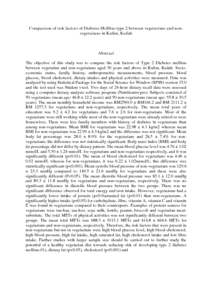Citation
Tan, Yong Khai and Abdul Ghani, Nawalyah
(2008)
Comparison of risk factors of Diabetes Mellitus type 2 between vegetarians and non-vegetarians in Kulim, Kedah.
Malaysian Journal of Nutrition, 14 (2 supplement).
S9-S10.
ISSN 1394-035X
Abstract
The objective of this study was to compare the risk factors of Type 2 Diabetes mellitus between
vegetarian and non-vegetarians aged 30 years and above in Kulim, Kedah. Socio-economic status,
family history, anthropometric measurements, blood pressure, blood glucose, blood cholesterol,
dietary intakes and physical activities were measured. Data was analysed by using Statistical
Package for the Social Science for Window (SPSS) version 15.0 and the test used was Student t-test.
Two days of 24-hour dietary recall data were assessed using a computer dietary analysis software
program (Nutritionist-pro). Subjects consisted of 50 vegetarians (mean age: 46.8 ± 12.2 years) and
50 non-vegetarians (mean age: 55.8 ± 10.5 years). The mean monthly household income was
RM2569.0 ± RM166.2 and RM 2111.2 ± RM 1257.3 for vegetarians and non-vegetarians, respectively.
The mean total years of education was 9.2 ± 4.2 for vegetarians and 7.6 ± 2.6 for non-vegetarians.
Most of the vegetarians were still working while most of the non-vegetarians were already
retired or were housewives. There were less family members with history of diabetes in vegetarians
than among non-vegetarians. Mean BMI for vegetarians was 22.98 ± 4.1 kg/m2 whereas mean BMI
for non-vegetarians was 22.99 ± 4.3 kg/m2 and the difference was not significant. Mean body fat
percentage was 28.0 ± 8.9% for the vegetarians and 28.5 ± 7.4% for non-vegetarians; the difference
was not statistically significant. Body mass index (BMI) and body fat percentage did not differ by
dietary pattern. The mean blood glucose level was 4.76 ± 1.02 mmol/L and 5.50 ± 1.24 mmol/L for
vegetarians and non-vegetarians respectively, and it was significantly different (p<0.01). The
mean of blood cholesterol for vegetarians was 4.46 ± 0.82 mmol/L whereas for non-vegetarians,
it was 6.22 ± 1.02mmol/L; this difference was statistically significant (p<0.001). Mean systolic
blood pressure of non-vegetarians was 129.6 ± 23.3 mmHg compared to 140.5 ± 21.6 mmHg for
vegetarians and these were also significantly different (P<0.05). The mean diastolic blood pressure
was 85.1 ± 12.0 mmHg and 89.3 ± 11.8 mmHg for vegetarians and non-vegetarians, respectively.
There was no significant difference in diastolic blood pressure between the two groups. There was
no significant difference observed for total energy and iron intake. However, vegetarians had a
significantly lower intake of protein (p<0.0saturated fat (p<0.01) than non-vegetarians. A significantly higher intake (p<0.05) for carbohydrate,
fibre, vitamin A, vitamin C and vitamin E was found in vegetarians compared to their counterparts.
Examples of protein sources for vegetarians were tau-kua, tau-hoo, soya milk, lentils, peanut,
broccoli and vegetarian meat-substitute. The total METs of physical activities was not significantly
different between two groups. The mean total METs was 688.3 ± 1913.1 METs and 414.8 ± 664.6
METs for vegetarians and non-vegetarians, respectively. Therefore, the risk factors that were
present in non-vegetarians but not in vegetarians were high blood glucose level, high blood
cholesterol, high blood pressure, high fat intake, high saturated fat, high cholesterol intake and
low fibre intake. Further studies with larger sample size should be carried out to further study the
potential of a healthy vegetarian diet towards reducing risk of developing type 2 diabetes mellitus.01), dietary fat (p<0.05), cholesterol (p<0.001) and
Download File
![[img]](http://psasir.upm.edu.my/6721/1.hassmallThumbnailVersion/Comparison%20of%20risk%20factors%20of%20Diabetes%20Mellitus%20type%202%20between%20vegetarians%20and%20non.pdf)  Preview |
|
PDF (Abstract)
Comparison of risk factors of Diabetes Mellitus type 2 between vegetarians and non.pdf
Download (85kB)
| Preview
|
|
Additional Metadata
Actions (login required)
 |
View Item |

